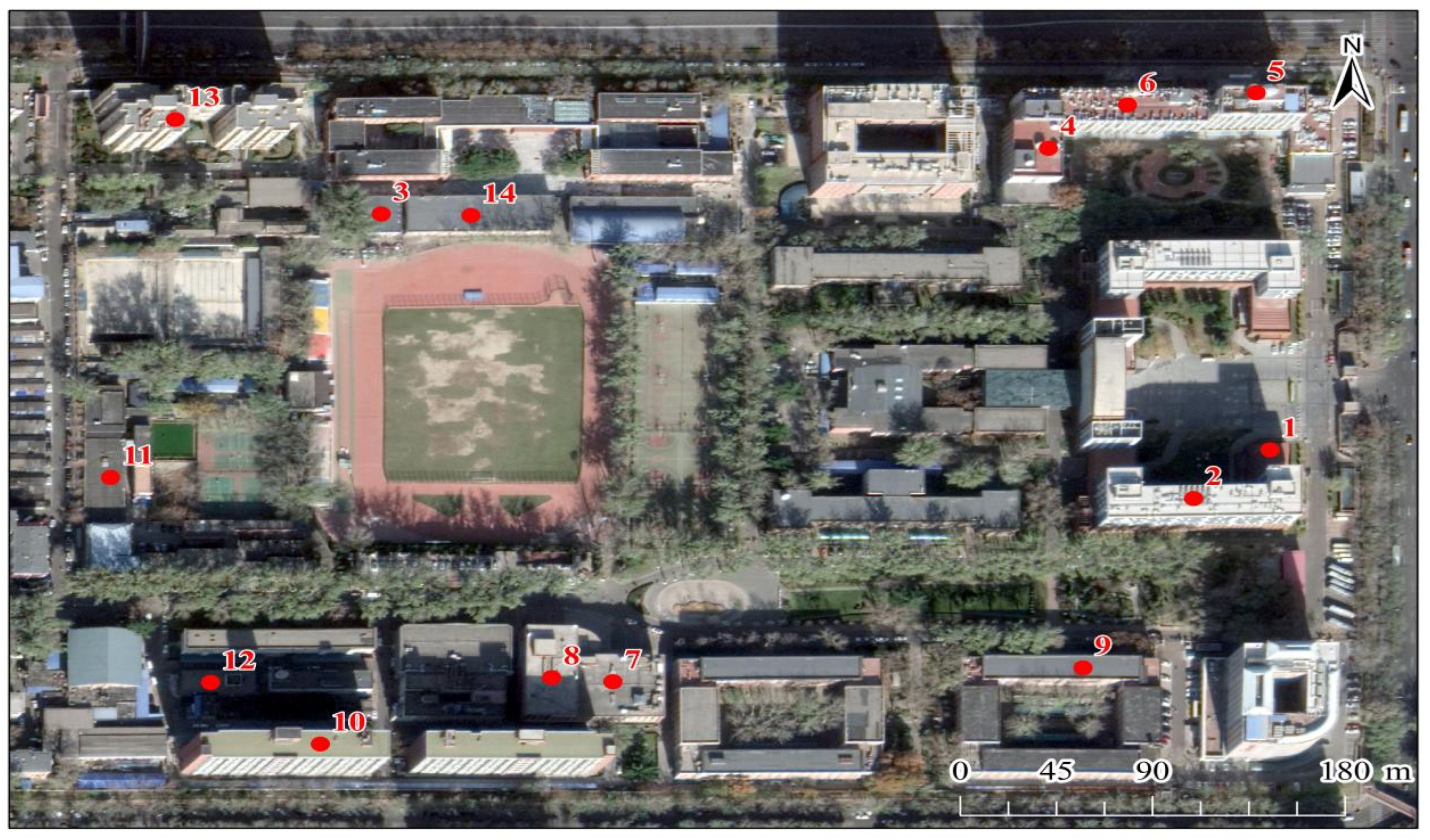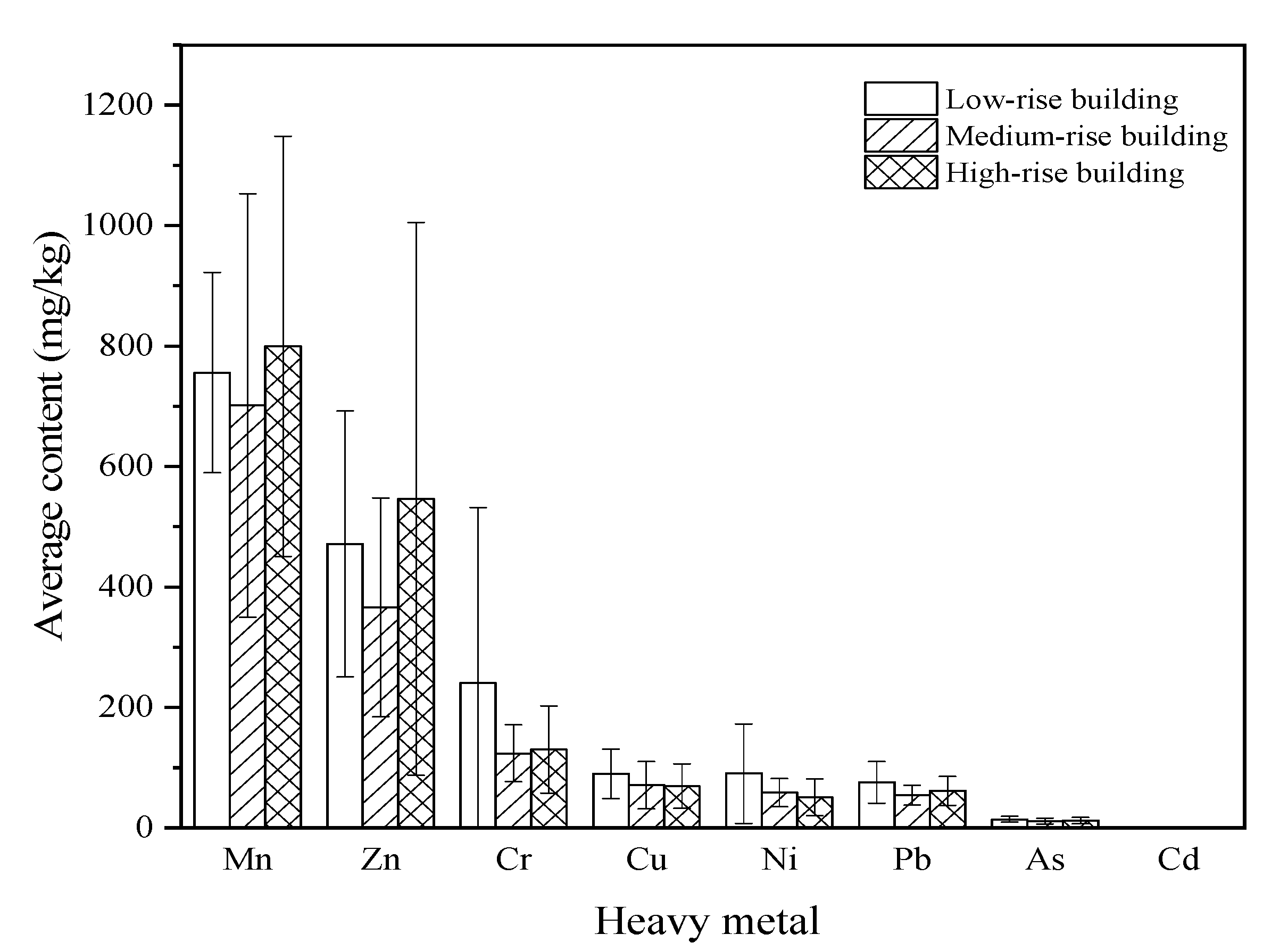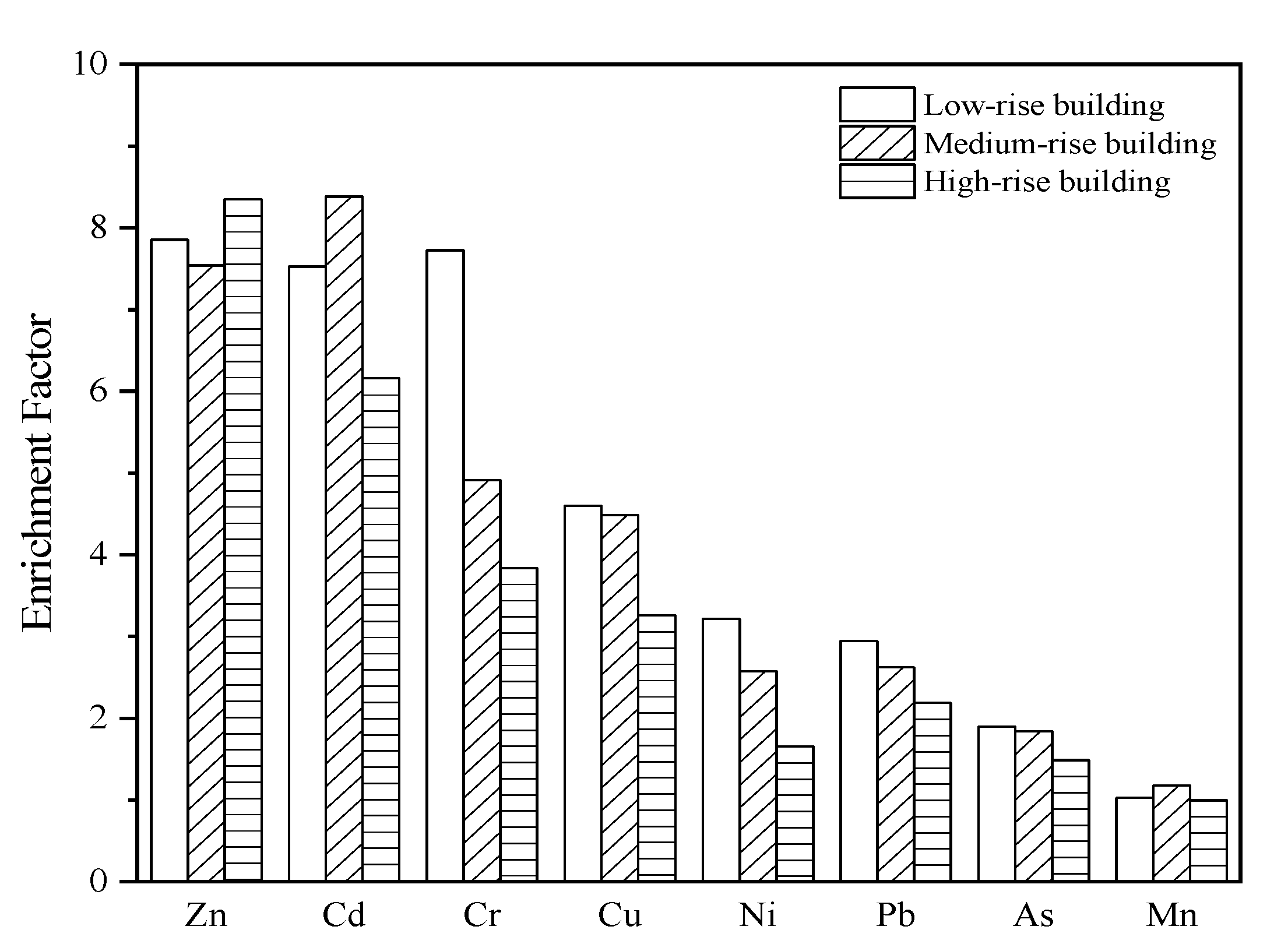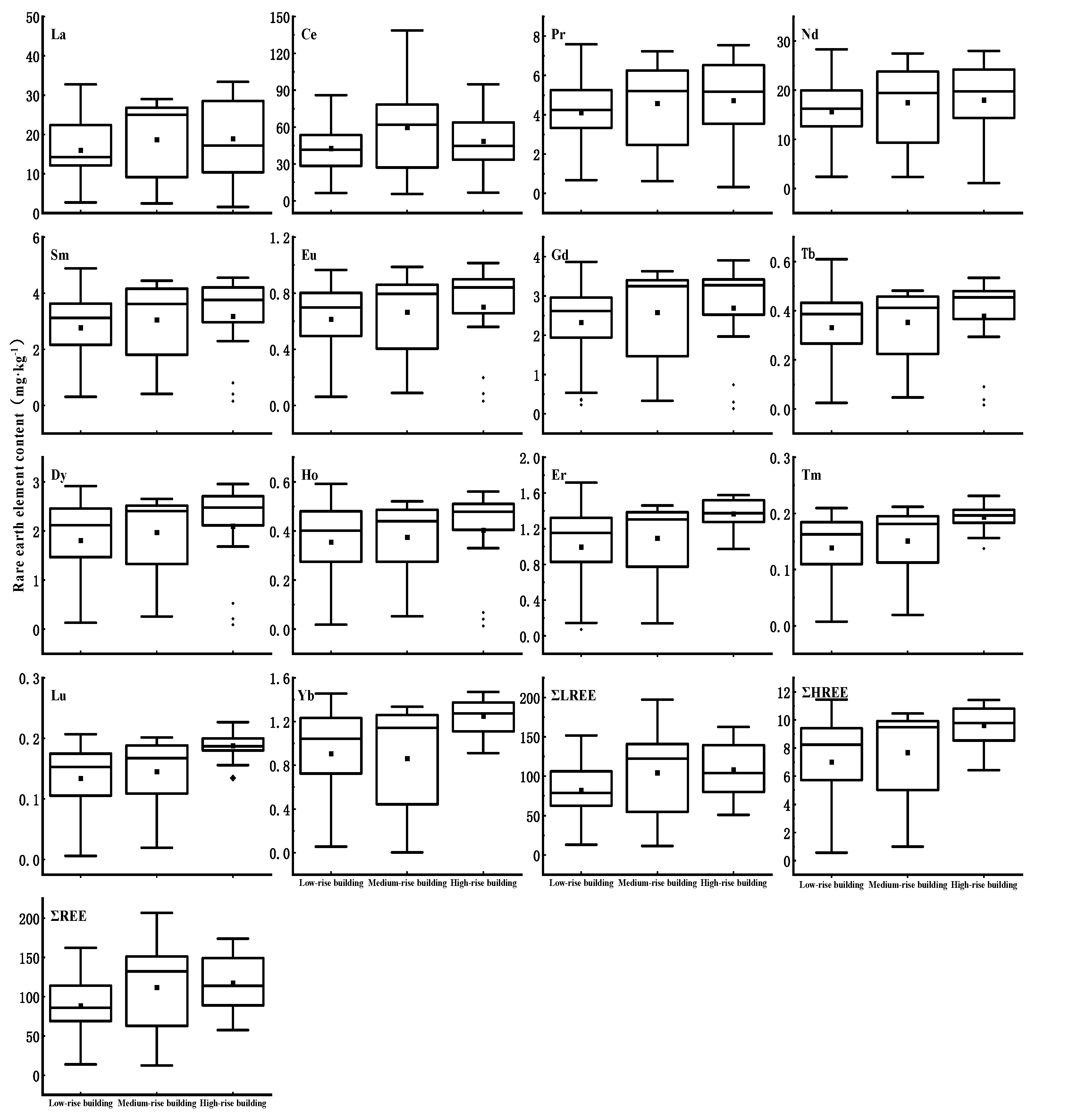Heavy Metal Pollution Characteristics and Source Analysis in the Dust Fall on Buildings of Different Heights
Abstract
:1. Introduction
2. Methods
2.1. Study Area and Sample Collection
2.2. Sample Treatment and Heavy Metal Detection and Analysis
2.3. Enrichment Factor
2.4. Pollution Characteristics of Heavy Metals in Dust Fall
2.4.1. Index of Geoaccumulation (Igeo)
2.4.2. Potential Ecological Risk Index
2.5. Source Analysis of Heavy Metals
2.5.1. Principal Component Analysis (PCA)
2.5.2. Rare Earth Element Analysis
3. Results
3.1. Content of Heavy Metal Elements in Dust Fall on the Rooftops of Urban Buildings
3.2. Heavy Metal EFs
3.3. Pollution Characteristics of Heavy Metals in Dust Fall
3.3.1. Geoaccumulation Index
3.3.2. Potential Ecological Risk Index
3.4. Analyses of Dust Fall and Heavy Metal Sources
3.4.1. Correlation Analyses
3.4.2. Principal Component Analysis
3.4.3. Rare Earth Element Analysis
4. Discussion
5. Conclusions
Author Contributions
Funding
Institutional Review Board Statement
Informed Consent Statement
Data Availability Statement
Acknowledgments
Conflicts of Interest
References
- Tang, R.L.; Ma, K.M.; Zhang, Y.X.; Mao, Q. The spatial characteristics and pollution levels of metals in urban street dust of Beijing, China. Appl. Geochem. 2013, 35, 88–98. [Google Scholar] [CrossRef]
- Kampa, M.; Castanas, E. Human health effects of air pollution. Environ. Pollut. 2008, 151, 362–367. [Google Scholar] [CrossRef] [PubMed]
- Wang, S.H.; Zhang, K.; Chai, F.H.; Zhong, X.C.; Zhou, G.Z.; Yang, Q.; Ke, X.S. Characteristics and sources of elements in atmospheric dust fall in Zhuzhou City, Central China. Chin. J. Environ. Sci. 2017, 38, 3130–3138. [Google Scholar]
- Li, P.; Xue, S.Y.; Wang, S.L.; Nan, Z.R. Pollution evaluation and health risk assessment of heavy metals from atmospheric deposition in Lanzhou. Chin. J. Environ. Sci. 2014, 35, 1021–1028. [Google Scholar]
- Xiaoxia, Z.; Wenji, Z.; Xiaoyu, G. Spatial variations of airborne dust trace elements in Beijing. China Environ. Sci. 2015, 35, 2251–2260. [Google Scholar]
- Zhao, W.T.; Chen, J.; Hu, W.P.; Huang, T.; Guo, L.; Cheng, S.G.; Gu, X.W. Distribution characteristics of heavy metals in PM2.5, PM10 and TSP around electroplating factories and the health risk assessment. Asian J. Ecotoxicol. 2017, 12, 470–484. [Google Scholar]
- Liu, M.D.; Li, Y.; Zhang, W.; Wang, Y. Assessment and spatial distribution of zinc pollution in agricultural soils of Chaoyang, China. Procedia Environ. Sci. 2013, 18, 283–289. [Google Scholar] [CrossRef]
- Khuzestani, R.B.; Souri, B. Evaluation of heavy metal contamination hazards in nuisance dust particles, in Kurdistan Province, western Iran. J. Environ. Sci. 2013, 25, 1346–1354. [Google Scholar] [CrossRef]
- Xia, D.S.; Wang, B.; Yu, Y.; Jia, J.; Nie, Y.; Wang, X.; Xu, S.J. Combination of magnetic parameters and heavy metals to discriminate soil-contamination sources in Yinchuan--a typical oasis city of Northwestern China. Sci. Total Environ. 2014, 485–486, 83–92. [Google Scholar] [CrossRef]
- GB50352-2019 Code for Design of Civil Buildings. Available online: https://www.mohurd.gov.cn/gongkai/fdzdgknr/tzgg/201905/20190530_240715.html (accessed on 18 August 2022).
- Ge, Y.N.; Xu, X.L.; Li, J.; Cai, H.Y.; Zhang, X.X. Study on the influence of urban building density on the heat island effect in Beijing. Geogr. Inf. Sci. 2016, 18, 1698–1706. [Google Scholar]
- GB/T15265-94 Ambient Air-Determination of Dustfall-Gravimetric Method. Available online: https://www.mee.gov.cn/ywgz/fgbz/bz/bzwb/jcffbz/199506/t19950601_67528.shtml (accessed on 18 August 2022).
- Zoller, W.H.; Gladney, E.S.; Duce, R.A. Atmospheric concentrations and sources of trace metals at the south pole. Science 1974, 183, 198–200. [Google Scholar] [CrossRef] [PubMed]
- Fan, X.T.; Jiang, Y.X.; Cui, B.; Chao, S.H.; Zhu, M.L.; Zeng, X.C.; Liu, J.W.; Cao, H.B. Selection of a reference element for enrichment factor: A case study on the pollution evaluation of heavy metals in the sediment of Yuan River. J. Acta Sci. Circumstantiae. 2016, 36, 3795–3803. [Google Scholar]
- Hu, Y.Q.; Guo, J.H.; Zhang, C.; Wang, Z.; Yan, X.; Yang, D.Y.; Liu, Z.Y. Characteristics and interannual variation of chemical components in typical road dust in Beijing. Environ. Sci. 2019, 40, 1645–1655. [Google Scholar]
- Bahena-Manjarrez, J.; Rosales-Hoz, L.; Carranza-Edwards, A. Spatial and temporal variation of heavy metals in a tropical estuary. Environ. Geol. 2002, 42, 575–582. [Google Scholar]
- Bai, L.; Wang, Z. Anthropogenic Influence on Rainwater in the Xi’an City, Northwest China: Constraints from sulfur isotope and trace element analyses. J. Geochem. Explor. 2014, 137, 65–72. [Google Scholar] [CrossRef]
- Muller, G. Index of geoaccumulation in sediments of the Rhine River. Geol. J. 1969, 2, 108–118. [Google Scholar]
- Xinming, Y.; Zhong, Y.Q.; Li, G.; Liao, Y.; Cai, C.; Chi, H. Distribution characteristic and source apportionment of heavy metals in atmospheric dust in a typical industrial city—A case study of Jinan. Environ. Chem. 2022, 41, 94–103. [Google Scholar]
- Zhang, X.; Liu, B.; Xiao, B.L.; Wang, J.; Wan, D. Pollution characteristics and assessment of heavy metals in atmospheric deposition in core urban areas, Chongqing. Huan Jing Ke Xue 2020, 41, 5288–5294. [Google Scholar]
- Xiong, Q.L.; Zhao, J.Y.; Zhao, W.J.; Wang, H.F.; Li, W.W.; Yu, X.; Ou, Y.; Yang, X.C. Pollution characteristics and potential ecological risks of heavy metals in topsoil of Beijing. China Environ. Sci. 2017, 37, 2211–2221. [Google Scholar]
- Zhao, Z.L.; Zhao, W.T.; Huang, T.; Cheng, S.G.; Yu, C.C.; Yin, Y.M. Seasonal characteristics and ecological risk assessment of heavy metals in pm10 around electroplating plants. Chin. J. Environ. Sci. 2018, 39, 18–26. [Google Scholar]
- Xi, X.H.; Hou, Q.Y.; Yang, Z.F.; Ye, J.Y.; Yu, T.; Xia, X.Q.; Cheng, H.X.; Zhou, G.H.; Yao, L. Big data based studies of the variation features of Chinese soil’s background value vs. reference value: A paper written on the occasion of soil geo-chemical parameters of China’s Publication. Geo-Phys. Geochem. Explor. 2021, 45, 1095–1108. [Google Scholar]
- Hakanson, L. An ecological risk index for aquatic pollution control. A sedimentological approach. Water Res. 1980, 14, 975–1001. [Google Scholar] [CrossRef]
- Zhang, Y. Chemical Composition and Pb, Sr Isotopes Tracing of PM2.5 in Quanzhou. Ph.D. Thesis, Huaqiao University, Quanzhou, China, 2017. [Google Scholar]
- Xu, Z.Q.; Ni, X.J.; Tuo, X.G.; Zhang, C.J. Calculation of heavy metals’ toxicity coefficient in the evaluation of potential ecological risk index. Environ. Sci. Technol. 2008, 31, 112–115. [Google Scholar]
- Xiong, Q.L.; Zhao, W.J.; Guo, X.Y.; Chen, F.T.; Shu, T.T.; Zheng, X.X.; Zhao, W.H. Distribution characteristics and source analysis of dustfall trace elements during winter in Beijing. Environ. Sci. 2015, 36, 2735–2742. [Google Scholar]
- Zongwei, Z. Pollution Characteristics and Source Apportionment of Heavy Metals and Rare Earth Elements in Atmospheric Particles of Quanzhou City. Master’s Thesis, Huaqiao University, Quanzhou, China, 2017. [Google Scholar]
- Chen, T.B.; Zheng, Y.M.; Chen, H.; Zheng, G.D. Background concentrations of soil heavy metals in Beijing. Environ. Sci. 2004, 25, 117–122. [Google Scholar]
- The National Environment Monitoring Station. Background Values of Soil Elements in China; China Environmental Science Press: Beijing, China, 2014; Available online: http://ir.imde.ac.cn/handle/131551/6392 (accessed on 18 August 2022).
- Gao, Y.; Nelson, E.D.; Field, M.P.; Ding, Q.; Li, H.; Sherrell, R.M.; Gigliotti, C.L.; Van Ry, D.A.; Glenn, T.R.; Eisenreich, S.J. Characterization of atmospheric trace elements on PM2.5 particulate matter over the New York-New Jersey harbor estuary. Atmos. Environ. 2002, 36, 1077–1086. [Google Scholar] [CrossRef]
- Lv, J.S.; Zhang, Z.L.; Liu, Y.; Dai, J.R.; Wang, X.; Wang, M.X. Sources identification and hazardous risk delineation of heavy metals contamination in Rizhao City. Acta Geogr. Sin. 2012, 7, 109–122. [Google Scholar]
- Lv, J.S.; Liu, Y.; Zhang, Z.L.; Dai, J. Factorial kriging and stepwise regression approach to identify environmental factors influencing spatial multi-scale variability of heavy metals in soils. J. Hazard. Mater. 2013, 261, 387–397. [Google Scholar] [CrossRef]
- Qin, X.; Zhang, Z.F.; Li, Y.W.; Shen, Y.; Zhao, S.H. Sources analysis of heavy metal aerosol particles in north suburb of Nanjing. HuanJing Ke Xue 2016, 37, 4467–4474. [Google Scholar]
- Bourliva, A.; Christophoridis, C.; Papadopoulou, L.; Giouri, K.; Papadopoulos, A.; Mitsika, E.; Fytianos, K. Characterization, heavy metal content and health risk assessment of urban road dusts from the historic center of the city of Thessaloniki, Greece. Environ. Geochem. Health 2017, 39, 611–634. [Google Scholar] [CrossRef]
- Zheng, Y.M.; Chen, H.; Chen, T.B.; Zheng, G.D.; Wu, H.T.; Zhou, J.L. Spatial distribution patterns of Cr and Ni in soils of Beijing. Quat. Sci. 2003, 23, 436–445. [Google Scholar]
- Wang, M.S.; Cao, J.L.; Li, H.; Gui, C.L.; Song, D.Y. Ecological risk assessment and source analysis of heavy metals in dust-fall in Jiaozuo City, China. Ecol. Environ. Sci. 2017, 26, 824–830. [Google Scholar]
- Wei, F.S.; Liu, Y.L.; Teng, E.J.; Rui, K.S. Rare earth elements in Chinese soil. Chin. J. Environ. Sci. 1991, 12, 78–82. [Google Scholar]
- Yan, M.C.; Chi, Q.H.; Gu, T.X.; Wang, C.S. The average content of chemical elements in sediments of China. Geophys. Geochem. Explor. 1995, 19, 468–472. [Google Scholar]
- Wang, J. Applications and new advance of rare earth in functional materials. Chem. Propellants Polym. Mater. 2003, 1, 29–33. [Google Scholar]
- Hu, J.; Yang, C.G.; Guo, J.; Chen, Z. Pollution characteristics of heavy metal elements in PM2.5 of autumn and winter in Guiyang City. Chin. J. Environ. Chem. Chin. J. 2014, 33, 530–532. [Google Scholar]





| Pollution Level | EF | Enrichment Degree |
|---|---|---|
| I | EF < 1 | No enrichment |
| 1 ≤ EF < 2 | Slight enrichment | |
| II | 2 ≤ EF < 5 | Moderate enrichment |
| III | 5 ≤ EF < 20 | Significant enrichment |
| IV | 20 ≤ EF < 40 | Strong enrichment |
| V | EF ≥ 40 | Extremely strong enrichment |
| Grade | Igeo | Degree of Pollution |
|---|---|---|
| 0 | Igeo ≤ 0 | Pollution-free |
| 1 | 0 < Igeo ≤ 1 | Slight pollution |
| 2 | 1 < Igeo ≤ 2 | Mild pollution |
| 3 | 2 < Igeo ≤ 3 | Moderate pollution |
| 4 | 3 < Igeo ≤ 4 | High pollution |
| 5 | 4 < Igeo ≤ 5 | Heavy pollution |
| 6 | Igeo > 5 | Severe pollution |
| (Single-Factor Potential Ecological Hazard Coefficient) | RI (Total Potential Ecological Risk Hazard Index) | Potential Ecological Risk Degree |
|---|---|---|
| <40 | <150 | Low ecological risk |
| 40–80 | 150–300 | Moderate ecological risk |
| 80–160 | 300–600 | Considerable ecological risk |
| 160–320 | 600–1200 | High ecological risk |
| ≥320 | ≥1200 | Very high ecological risk |
| Heavy Metal | Data | Low-Rise Building | Medium-Rise Building | High-Rise Building | Background Value (mg/kg) |
|---|---|---|---|---|---|
| Cr | Average | 265.1 | 123.7 | 130.1 | 29.8 |
| Standard deviation (SD) | 291.7 | 47.3 | 72.4 | ||
| Coefficient of variation (CV) | 1.2 | 0.4 | 0.6 | ||
| Mn | Average | 756.0 | 701.4 | 799.5 | 705 |
| SD | 166.3 | 351.5 | 348.9 | ||
| CV | 0.2 | 0.5 | 0.4 | ||
| Ni | Average | 89.1 | 58.3 | 50.5 | 26.8 |
| SD | 82.6 | 23.3 | 30.3 | ||
| CV | 0.9 | 0.4 | 0.6 | ||
| Cu | Average | 89.8 | 70.8 | 69.3 | 18.7 |
| SD | 41.3 | 39.5 | 36.8 | ||
| CV | 0.5 | 0.6 | 0.5 | ||
| Zn | Average | 471.3 | 366.1 | 546.6 | 57.5 |
| SD | 220.8 | 181.8 | 458.9 | ||
| CV | 0.5 | 0.5 | 0.8 | ||
| As | Average | 14.0 | 11.0 | 12.0 | 7.09 |
| SD | 4.9 | 4.8 | 5.3 | ||
| CV | 0.3 | 0.4 | 0.4 | ||
| Cd | Average | 0.9 | 0.8 | 0.8 | 0.119 |
| SD | 0.5 | 0.4 | 0.4 | ||
| CV | 0.6 | 0.5 | 0.5 | ||
| Pb | Average | 75.7 | 54.5 | 61.2 | 24.6 |
| SD | 34.7 | 16.6 | 24.1 | ||
| CV | 0.5 | 0.3 | 0.4 |
| Heavy Metal | Data | Low-Rise Building | Medium-Rise Building | High-Rise Building |
|---|---|---|---|---|
| Cr | Igeo | 1.35 | 0.39 | 0.46 |
| Pollution degree | Mild pollution | Slight pollution | Slight pollution | |
| Pollution level | 2 | 1 | 1 | |
| Mn | Igeo | −0.13 | −0.24 | −0.05 |
| Pollution degree | Pollution-free | Pollution-free | Pollution-free | |
| Pollution level | 0 | 0 | 0 | |
| Ni | Igeo | 1.21 | 0.58 | 0.37 |
| Pollution degree | Mild pollution | Slight pollution | Slight pollution | |
| Pollution level | 2 | 1 | 1 | |
| Cu | Igeo | 1.38 | 1.04 | 1.01 |
| Pollution degree | Mild pollution | Mild pollution | Mild pollution | |
| Pollution level | 2 | 2 | 2 | |
| Zn | Igeo | 2.23 | 1.86 | 2.44 |
| Pollution degree | Moderate pollution | Mild pollution | Moderate pollution | |
| Pollution level | 3 | 2 | 3 | |
| As | Igeo | 0.04 | −0.31 | −0.18 |
| Pollution degree | Slight pollution | Pollution-free | Pollution-free | |
| Pollution level | 2 | 0 | 0 | |
| Cd | Igeo | −7.74 | −7.89 | −7.91 |
| Pollution degree | Pollution-free | Pollution-free | Pollution-free | |
| Pollution level | 0 | 0 | 0 | |
| Pb | Igeo | 1.01 | 0.54 | 0.71 |
| Pollution degree | Mild pollution | Slight pollution | Slight pollution | |
| Pollution level | 2 | 1 | 1 |
| Cr | Mn | Ni | Cu | Zn | As | Cd | Pb | |
|---|---|---|---|---|---|---|---|---|
| Cr | 1 | |||||||
| Mn | 0.052 | 1 | ||||||
| Ni | 0.950 ** | −0.052 | 1 | |||||
| Cu | 0.362 | 0.639 ** | 0.252 | 1 | ||||
| Zn | 0.370 | 0.426 * | 0.217 | 0.734 ** | 1 | |||
| As | 0.349 | 0.341 | 0.241 | 0.346 | 0.287 | 1 | ||
| Cd | 0.339 | 0.386 | 0.257 | 0.594 ** | 0.671 ** | 0.394 * | 1 | |
| Pb | 0.333 | 0.329 | 0.389 * | 0.665 ** | 0.615 ** | 0.247 | 0.593 ** | 1 |
| Initial Eigenvalue | Sum of Squares of Loads | |||||
|---|---|---|---|---|---|---|
| Total | Variance (%) | Cumulative (%) | Total | Variance (%) | Cumulative (%) | |
| 1 | 3.926 | 49.077 | 49.077 | 3.926 | 49.077 | 49.077 |
| 2 | 1.660 | 20.745 | 69.822 | 1.660 | 20.745 | 69.822 |
| 3 | 0.870 | 10.875 | 80.697 | 0.870 | 10.875 | 80.697 |
| 4 | 0.602 | 7.523 | 88.220 | |||
| 5 | 0.416 | 5.203 | 93.423 | |||
| 6 | 0.332 | 4.155 | 97.578 | |||
| 7 | 0.180 | 2.255 | 99.833 | |||
| 8 | 0.013 | 0.167 | 100.000 | |||
| Heavy Metal | Component | ||
|---|---|---|---|
| 1 | 2 | 3 | |
| Cr | 0.640 | 0.729 | 0.070 |
| Mn | 0.560 | −0.551 | 0.294 |
| Ni | 0.548 | 0.811 | −0.028 |
| Cu | 0.853 | −0.285 | −0.084 |
| Zn | 0.813 | −0.226 | −0.241 |
| As | 0.539 | 0.022 | 0.763 |
| Cd | 0.786 | −0.169 | −0.081 |
| Pb | 0.778 | −0.070 | −0.352 |
Publisher’s Note: MDPI stays neutral with regard to jurisdictional claims in published maps and institutional affiliations. |
© 2022 by the authors. Licensee MDPI, Basel, Switzerland. This article is an open access article distributed under the terms and conditions of the Creative Commons Attribution (CC BY) license (https://creativecommons.org/licenses/by/4.0/).
Share and Cite
Song, H.; Li, J.; Li, L.; Dong, J.; Hou, W.; Yang, R.; Zhang, S.; Zu, S.; Ma, P.; Zhao, W. Heavy Metal Pollution Characteristics and Source Analysis in the Dust Fall on Buildings of Different Heights. Int. J. Environ. Res. Public Health 2022, 19, 11376. https://doi.org/10.3390/ijerph191811376
Song H, Li J, Li L, Dong J, Hou W, Yang R, Zhang S, Zu S, Ma P, Zhao W. Heavy Metal Pollution Characteristics and Source Analysis in the Dust Fall on Buildings of Different Heights. International Journal of Environmental Research and Public Health. 2022; 19(18):11376. https://doi.org/10.3390/ijerph191811376
Chicago/Turabian StyleSong, Hanyang, Jinxiang Li, Lingjun Li, Jie Dong, Wenxing Hou, Ran Yang, Shanwen Zhang, Sida Zu, Pengfei Ma, and Wenji Zhao. 2022. "Heavy Metal Pollution Characteristics and Source Analysis in the Dust Fall on Buildings of Different Heights" International Journal of Environmental Research and Public Health 19, no. 18: 11376. https://doi.org/10.3390/ijerph191811376





